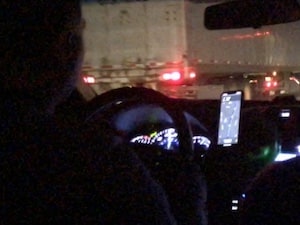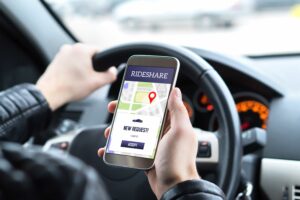You did what millions of Chicagoans do every day. You opened an app, requested a ride, and placed your trust in a stranger to get you to your destination safely.
You settled into the backseat, looking at your phone or watching the city pass by, completely unaware that in a few moments, your life would be violently altered by the squeal of tires and the crushing force of impact.
Now, sitting in the aftermath of a wreck, you are injured, confused, and facing a complex legal situation that involves powerful corporations and multiple insurance policies.
When your Uber or Lyft driver causes your injuries, knowing your rideshare passenger rights is the first step, and having a powerful law firm enforce them is the only way forward.
Your roadmap after a rideshare wreck

When you are injured as a passenger, the legal landscape is far more complicated than in a typical car accident. These are the core principles your attorney will use to build your case and fight for the justice you are owed.
- As an innocent passenger, you are almost never considered at fault for the collision. The legal fight is not about your actions, but about determining which driver and which massive insurance company is responsible for your injuries.
- Uber and Lyft are protected by multi-million dollar commercial insurance policies. However, these companies do not make it easy to access this coverage; it requires a specific and aggressive legal strategy from a law firm that knows how to fight them.
- The critical evidence in a rideshare crash, like the driver's app status, GPS data, and dashcam footage, is digital and can be erased. An attorney must act immediately to send legal preservation notices to protect this information.
- You will be facing multiple insurance adjusters from different companies, all working to minimize their own company's payout. A lawyer takes over all these communications, shielding you from their tactics and managing the entire claims process.
The Unique Complexity of a Rideshare Accident Claim
Being injured in an Uber or Lyft is fundamentally different from being in a standard two-car collision. In a typical crash, the dispute is between two drivers and their respective insurance carriers.
In a rideshare accident, you are an innocent passenger caught in a web that may involve your driver, another driver, their personal insurance companies, and the massive corporate legal teams of Uber or Lyft.
These rideshare giants, valued in the tens of billions of dollars, have armies of attorneys and adjusters whose sole purpose is to protect the company's bottom line. They have designed a system of insurance coverage that is intentionally complicated, creating layers of liability that can be difficult to penetrate without experienced legal representation.
They will often try to distance themselves from their driver's negligence, arguing that the driver is merely an "independent contractor." This is a legal maneuver designed to shield the company from responsibility.
Your attorney’s job is to cut through these corporate shields and hold the correct parties accountable for the harm you have suffered.
How a Lawyer Determines Which Insurance Policy Applies
The most critical factor in any rideshare accident claim is the status of the driver's app at the exact moment of the crash. This single piece of data determines which insurance policy is active and the amount of coverage available.
This is not information that Uber or Lyft will volunteer. It must be legally demanded and verified by your law firm. Illinois law, specifically the Transportation Network Providers Act, sets specific insurance requirements based on the driver's activity.
The Three Periods of Rideshare Insurance
The law creates distinct insurance periods, and your attorney's first action is to legally establish which period the driver was in when you were injured. This is a foundational step that your entire case will be built upon.
- Period 1: The App is On, Awaiting a Ride Request. During this time, the driver’s personal auto insurance is the primary coverage. If that policy denies a claim, which it often does for commercial activity, a lower level of liability coverage from the rideshare company is available.
- Period 2: A Request is Accepted, and the Driver is En Route. Once the driver accepts your ride request and is on the way to pick you up, a higher level of rideshare insurance becomes active. This typically includes at least $1 million in liability coverage.
- Period 3: The Passenger is in the Vehicle. This is the period that applies to you as an injured passenger. From the moment you enter the vehicle until you exit, you are covered by the rideshare company’s highest-tier commercial insurance policy. This includes at least $1 million in liability coverage and another $1 million in Uninsured/Underinsured Motorist (UIM) coverage.
Your rideshare accident lawyer will take immediate legal action to obtain the electronic data from Uber or Lyft to prove you were in Period 3. This is a non-negotiable first step in building your claim for compensation.
When Your Rideshare Driver is at Fault: Your Lawyer’s Action Plan
Imagine your Uber driver is looking at their phone for directions, runs a red light, and slams into another car. Or perhaps your Lyft driver is speeding to complete a trip and loses control.
In these situations, their negligence is the direct cause of your injuries. As their passenger, you have a direct claim against the rideshare company’s powerful commercial insurance policy.
However, securing this compensation is an aggressive legal process. Your law firm will take a series of decisive actions on your behalf to force the company to pay what is owed.
Your attorney will manage every aspect of the claim. This is a complex legal fight that a lawyer will handle for you. The immediate actions taken to build your case include:
- Formally demanding that Uber or Lyft preserve all electronic data related to your trip.
- Filing a direct claim against the rideshare company’s $1 million commercial liability policy.
- Aggressively countering any attempts by the company to deny responsibility by blaming their driver.
- Obtaining and analyzing the driver’s history, driving record, and any prior complaints.
- Working with medical professionals to document the full extent and cost of your injuries.
This legal strategy is designed to hold the rideshare company directly responsible for the actions of the driver they put on the road.
When Another Driver is at Fault: Your Lawyer’s Two-Front Strategy

Now, consider a different scenario. Your Uber driver is operating safely, but another vehicle blows through a stop sign and T-bones your rideshare. In this case, the other driver is clearly at fault.
However, this does not mean the process is simple. It often requires a two-front legal strategy, managed entirely by your attorney. The first step your lawyer will take is to pursue a claim against the at-fault driver’s personal auto insurance policy.
Unfortunately, many drivers in Illinois carry only the state-minimum liability coverage, which is often completely insufficient to cover the medical bills, lost wages, and suffering from a serious injury.
This is where the rideshare company's insurance becomes a vital safety net for you. When the at-fault driver's insurance is exhausted, your lawyer then pivots to open a second claim.
This is a claim against the Uninsured/Underinsured Motorist (UIM) coverage provided by Uber or Lyft. This $1 million policy exists specifically to protect passengers like you from being left with inadequate compensation due to the negligence of another driver.
Your attorney will execute a precise legal strategy. This complex process is something a lawyer manages for you from start to finish.
The steps include:
- Quickly investigating and establishing the other driver's fault.
- Securing the policy limits from the at-fault driver’s insurance carrier.
- Formally notifying the rideshare company of a pending UIM claim.
- Compiling all medical and financial evidence to prove your damages exceed the first driver's policy.
- Aggressively negotiating with the rideshare company’s UIM adjusters to pay the remainder of your claim.
This two-step process is legally intricate and requires an attorney who is experienced in handling these specific types of claims.
Your Law Firm’s Immediate Actions to Protect Your Claim
The first 48 hours after a rideshare accident are a critical time for evidence preservation. While you are focused on getting medical attention, a dedicated law firm is already taking action to protect your legal rights.
This is not a list of tasks for you to perform; this is what your legal team does for you the moment you hire them.
Sending legal preservation demands
Your attorney will immediately draft and send legally binding preservation letters to all involved parties. This includes the rideshare company, your driver, and any other drivers.
These letters demand that they do not delete, alter, or destroy any piece of evidence related to the crash. This includes app data, GPS logs, dashcam footage, vehicle maintenance records, and cell phone data.
Launching an independent investigation
The police report is a starting point, but it is rarely the whole story. Your law firm will launch its own private investigation. This may involve dispatching investigators to the accident scene, locating and interviewing witnesses the police may have missed, and pulling surveillance footage from nearby buildings that can show exactly what happened.
Taking over all communications
From the moment you are represented, your lawyer becomes your voice and your shield. The law firm will formally notify all insurance companies that you have legal counsel and instruct them to direct all future communications to the firm.
This immediately stops the endless calls from adjusters and protects you from being tricked into giving a recorded statement that could be used against you.
AI Tools Can't Represent You in a Rideshare Claim
An artificial intelligence program can tell you what Uber's insurance policy is, but it cannot file a legal claim against it. It cannot depose a negligent driver, analyze complex accident reconstruction data, or argue your case in a Cook County courthouse.
For actual representation in a complex rideshare injury case, you need a dedicated human attorney to fight for you and your rights.
Contact a Chicago Rideshare Accident Law Firm Today
As an injured rideshare passenger, you are in a vulnerable position. You are facing powerful corporate interests and multiple insurance companies that are not on your side. You do not have to face this fight alone.

You need a powerful legal advocate who will take control of your case and demand the justice and compensation you are owed.
Let us fight for you. The attorneys at Abels & Annes, P.C. have the experience and resources to take on Uber, Lyft, and their insurance carriers. Call us now at (312) 924-7575 for your free, no-obligation consultation. We are available 24/7, and there is absolutely no fee unless you win.